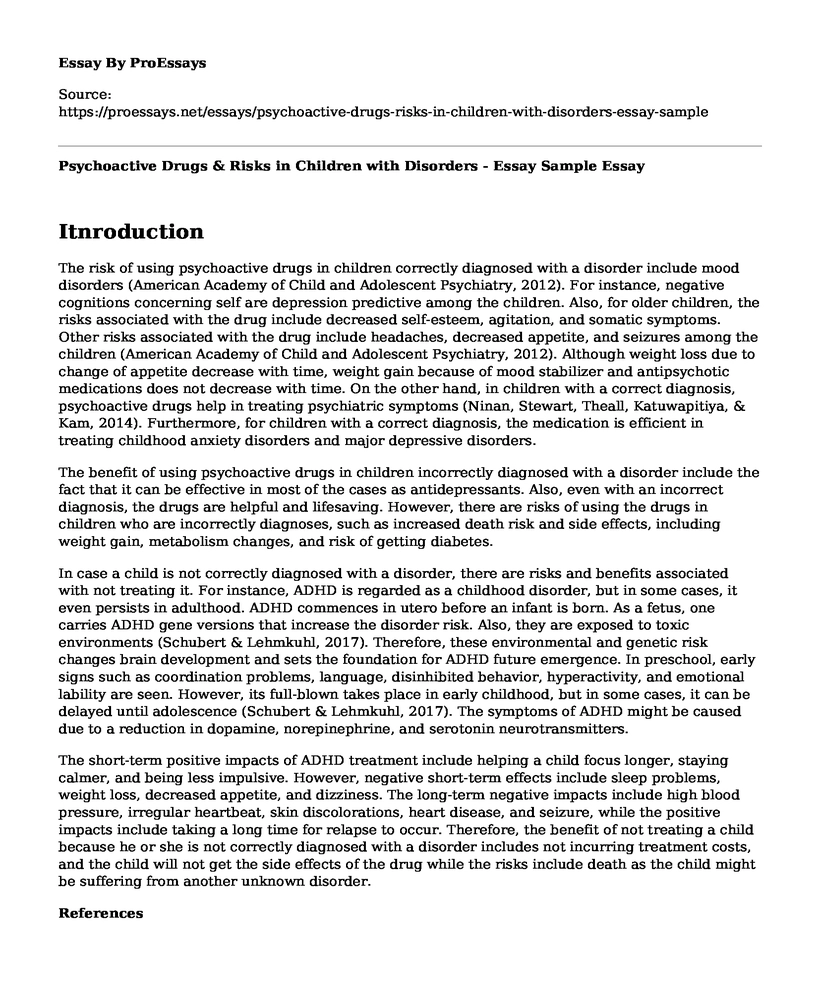Itnroduction
The risk of using psychoactive drugs in children correctly diagnosed with a disorder include mood disorders (American Academy of Child and Adolescent Psychiatry, 2012). For instance, negative cognitions concerning self are depression predictive among the children. Also, for older children, the risks associated with the drug include decreased self-esteem, agitation, and somatic symptoms. Other risks associated with the drug include headaches, decreased appetite, and seizures among the children (American Academy of Child and Adolescent Psychiatry, 2012). Although weight loss due to change of appetite decrease with time, weight gain because of mood stabilizer and antipsychotic medications does not decrease with time. On the other hand, in children with a correct diagnosis, psychoactive drugs help in treating psychiatric symptoms (Ninan, Stewart, Theall, Katuwapitiya, & Kam, 2014). Furthermore, for children with a correct diagnosis, the medication is efficient in treating childhood anxiety disorders and major depressive disorders.
The benefit of using psychoactive drugs in children incorrectly diagnosed with a disorder include the fact that it can be effective in most of the cases as antidepressants. Also, even with an incorrect diagnosis, the drugs are helpful and lifesaving. However, there are risks of using the drugs in children who are incorrectly diagnoses, such as increased death risk and side effects, including weight gain, metabolism changes, and risk of getting diabetes.
In case a child is not correctly diagnosed with a disorder, there are risks and benefits associated with not treating it. For instance, ADHD is regarded as a childhood disorder, but in some cases, it even persists in adulthood. ADHD commences in utero before an infant is born. As a fetus, one carries ADHD gene versions that increase the disorder risk. Also, they are exposed to toxic environments (Schubert & Lehmkuhl, 2017). Therefore, these environmental and genetic risk changes brain development and sets the foundation for ADHD future emergence. In preschool, early signs such as coordination problems, language, disinhibited behavior, hyperactivity, and emotional lability are seen. However, its full-blown takes place in early childhood, but in some cases, it can be delayed until adolescence (Schubert & Lehmkuhl, 2017). The symptoms of ADHD might be caused due to a reduction in dopamine, norepinephrine, and serotonin neurotransmitters.
The short-term positive impacts of ADHD treatment include helping a child focus longer, staying calmer, and being less impulsive. However, negative short-term effects include sleep problems, weight loss, decreased appetite, and dizziness. The long-term negative impacts include high blood pressure, irregular heartbeat, skin discolorations, heart disease, and seizure, while the positive impacts include taking a long time for relapse to occur. Therefore, the benefit of not treating a child because he or she is not correctly diagnosed with a disorder includes not incurring treatment costs, and the child will not get the side effects of the drug while the risks include death as the child might be suffering from another unknown disorder.
References
American Academy of Child and Adolescent Psychiatry. (2012). A guide for community child-serving agencies on psychotropic medications for children and adolescents. [White Paper] Source.
Ninan, A., Stewart, S. L., Theall, L. A., Katuwapitiya, S., & Kam, C. (2014). Adverse effects of psychotropic medications in children: Predictive factors. Journal of the Canadian Academy of Child and Adolescent Psychiatry, 23(3), 218.
Schubert, I., & Lehmkuhl, G. (2017). The natural course and treatment of ADHD, and its place in adulthood. Deutsches Ärzteblatt International, 114(9), 139.
Cite this page
Psychoactive Drugs & Risks in Children with Disorders - Essay Sample. (2023, Aug 12). Retrieved from https://proessays.net/essays/psychoactive-drugs-risks-in-children-with-disorders-essay-sample
If you are the original author of this essay and no longer wish to have it published on the ProEssays website, please click below to request its removal:
- Essay Sample on Human Trafficking and Suicide
- The Gerontological Explosion Essay
- Essay Sample on Mental Health and Depression
- Essay Sample on How Anxiety Disorders Affect Academic Performance
- Essay on Jesus on Anger: Hatred Equals Murder in Christian Beliefs
- Essay Example on Anxiety Diagnosis: Features & History to Elicit
- Essay Example on California Psychological Inventory (CPI) Assessment: Enhancing Performance







